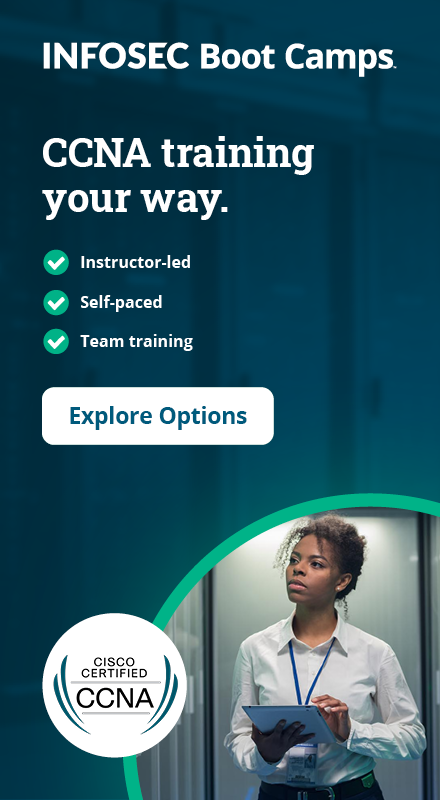CCNA certification overview and information [Updated 2020]
Introduction
The Cisco Certified Network Associate (CCNA) certification is among the best-known IT certs in the world. If someone wants to start a career in computer networking, this is a very good choice.
Cisco has continuously updated and revised the content through six major versions, and the current version has undergone many changes. In this article, we’ll go through the exam format and its current conditions.

Earn your CCNA, guaranteed!
What’s the goal of the CCNA exam?
“The CCNA certification validates your skills and knowledge in network fundamentals, network access, IP connectivity, IP services, security fundamentals, and automation and programmability” — this is what Cisco says. If you knew it before, the main content looks the same but now there’s bigger emphasis on some areas: security, wireless and the completely new automation and programmability.
The exam content has been streamlined and compressed a bit. The official course is three semesters instead of four, and there’s only one exam: no CCENT anymore. However, you get foundational knowledge in a few more areas. The traditional and classical routing and switching are redesigned, and some evergreen topics have disappeared (e.g., EIGRP).
There are more topics dealing with wireless and security; the latter is particularly important, as the CCNA Security certification is discontinued. The technology looks to be the future of networking and other IT areas, namely automation and programmability.
If we look at these changes as a whole, we can see that the goal of the new exam is to give a broad range of fundamentals in many areas and provide the learner with a base of knowledge from which they can move towards many certification paths.
Why did Cisco combine the CCNA, CCENT, CCDA and CCNA Security exams?
Up until now, the CCNA certification could be done in two ways: in one complex exam or two separate exams. This new version has only one exam, which is simpler and more transparent. Under the old system, you could choose various paths to continue in specializations after the base certification (security, design, voice, wireless and so on) and it was still the CCNA level. So there were a lot of options to choose from. Now the situation is much simpler: one curriculum and one exam, at least at the associate level. At the CCNP level, there are more paths available if you need deeper understanding in specific areas.
Cisco’s first intention in combining the old exams was likely that the certification paths be clearer and easier to choose. Secondly, they want CCNA network engineers to be able to communicate and work together more efficiently with developers. As technology evolves, network engineers need to have new abilities, and the new CCNA provides strong foundations for them.
What is the CCNA exam schedule, duration and format?
The new CCNA exam’s official name is Implementing and Administering Cisco Solutions and its code is 200-301. As I said before, there’s only one exam, which focuses on the following areas. The weight of the given topic in the whole exam material is given in parentheses.
- Network Fundamentals (20%)
- Network Access (20%)
- IP Connectivity (25%)
- IP Services (10%)
- Security Fundamentals (15%)
- Automation and Programmability (10%)
The duration of the exam is 120 minutes. There are some non-scored sections such as surveys or tutorials, and these can lengthen this time by 15-20 minutes. Also, if you’re not a native English speaker, you can get additional time.
You can expect about 100-120 questions from the following types: multiple choice (single and multiple answers), drag-and-drop, Sim, Simlet and Testlet. If the latter types are new to you, we suggest you view the exam tutorial videos here.
As before, you need to schedule your exam at Pearson VUE test centers. The test itself is PC-based, not pen-and-paper, but you can use some writing tools provided by the test center. Anything else is not permitted.
How to schedule and take the CCNA exam
You have to schedule your exam at a Pearson VUE test center. You’ll need to create an account, but once that’s done, you can get information about the places and exam times. You need to select Proctored exams, then CCNA, then code 200-301. The exam languages available are English and Japanese.
A new option is that you can take the exam at a local test center or at a home or office. In the latter case, there are also security precautions and you need to agree to the online exam policies. You can read more about that here.
Following the traditional way, you need to select a test center near you. If you prefer a given city, you can enter its name and find a test center there, then make an appointment for the exam. Finally, you pay the exam fee and confirm your scheduled time.
What are the identification requirements for CCNA testing?
When you arrive at the test center, you have to identify yourself. This can be done with two original and valid documents that have your signature and recognizable photo, such as your passport, driver’s license, federal ID or military ID. You will also need to submit a digital photograph and an electronic signature prior to testing.
Understanding the arrival process
It is recommended that you arrive at the facility at least 15 minutes before the test begins. Once you arrive, you will need to provide your identification to the center’s staff. When your identity has been verified, you will be escorted to the testing area.
You will have access to a locker to store your personal belongings, including purses, smartphones and so on. No electronic devices are allowed in the testing area. If you must leave the testing area while the exam is in progress, you will need to re-validate your identity before being allowed back into the testing area.
What are the policies for rescheduling, late arrivals and cancellations?
If you know that you can’t do the exam at the booked time, you can cancel it no less than 24 hours before. If you cancel or reschedule an exam under 24 hours in advance, you will forfeit your entire exam fee. If you arrive more than 15 minutes late for an exam, you will be responsible for payment of the exam and delivery fees as a no-show.
Certain circumstances may cause the cancellation of an exam, but you can reschedule it again. Please note, however, that a new booking should not be made within 24 hours of the original and there may be a charge for the procedure.
When should you schedule your CCNA exam?
If you feel that you’re ready to take the exam, it’s time to find a proper appointment. It may depend on the chosen test center and what time frames are available: you cannot choose any time randomly. When you schedule the exam on the Pearson VUE page, you can select from a list.
Test centers usually operate during regular business hours. However, some centers may have evening or weekend appointments available. Pay attention to the correct date and time, and time zone as well.
What happens if you fail the CCNA exam?
If you prepare well, you’ll certainly pass the exam. But if it’s unsuccessful, you have a chance to repeat it. The policies dictate that you cannot retake the same exam in five calendar days, beginning with the day after the failed attempt. Online exam takers must wait 48 hours for this.
There is also a policy for a successful exam: you cannot take the same exam within 180 days if you pass. Note that you will need to pay your certification/exam fee again.
What does the CCNA exam cost?
The exam price depends on the country you live in. You can see the exact actual prices here. For example, the actual fee in the US is $300, but it’s subject to change. However, if you have a voucher, you won’t pay as much. For example, if you attend a regular NetAcad course and pass your final exam with at least 70% on your first attempt, you’ll get a voucher. The discount may vary, and remember that the vouchers are valid only for a limited period of time.
What does it take to pass the CCNA exam?
The passing score is not specified exactly, but it’s about 800-850 points out of 1000. Although the time is longer (120 minutes), the number of questions is also higher — more than 100 questions expected. So you need to manage your time well.
Once you have passed, you will be emailed an electronic certificate of completion within three to five business days. You will receive a hardcopy version of your certificate within six to eight weeks. You’ll also get a digital certification badge (which you can share on social media if you want).
Conclusion
The new CCNA, codenamed 200-301, is the seventh major version of this curriculum and has brought the most changes of all. CCNA is one of Cisco’s most popular certifications and one of the most sought-after professional references in the technology industry. Obtaining a certificate can be the first step toward a career as an administrator or network engineer.

Earn your CCNA, guaranteed!
Although the new exam covers less ground than the old one, it also contains more relevant professional material. The duration of the exam and the number of questions has also increased, with the other conditions being more or less unchanged. If you’re ready to start a networking career, this certification is for you: begin the learning today!
Sources
- Exams and recommended training, Cisco
- Implementing and Administering Cisco Solutions (CCNA) v1.0, Cisco
- Exam and testing policies, Cisco
- Cisco voucher pricing, Pearson VUE
- Helpful resources for test-takers, Pearson VUE


